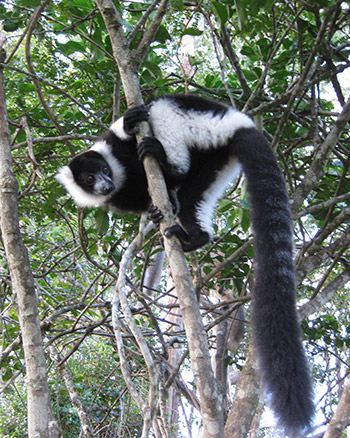
Courtesy of Sarah Federman
A recent Yale study highlights the place the centuries-extinct giant lemurs had within Madagascar’s forest ecosystem and gives new weight to the necessity of conserving surviving lemurs.
Researchers from the Yale Department of Ecology and Evolutionary Biology, along with partners from peer institutions, found that trees have been “orphaned” by the extinction about 500 to 1,700 years ago of the giant lemurs that once dispersed their seeds. According to study co-authors, the finding not only sheds light on the delicate balance of needs within Madagascar’s forests, but also lends more immediacy to lemur-conservation concerns. The study was published in the journal Proceedings of the National Academy of Sciences on April 11.
“These lemurs went extinct between 1,700 years and 500 years ago,” said Sarah Federman GRD ’18, lead author of the study. “From a tree’s perspective that was maybe a generation and a half ago, so they haven’t really had time to adjust to this changed dispersal landscape.”
Federman became interested in seed dispersal in Madagascar while studying the Canarium trees. According to F&ES professor Douglas Daly, who is also the director of the Institute of Systematic Botany at the New York Botanical Garden, Federman realized that there was a disconnect between the size of fruit of the Canarium trees and the size of the world’s surviving lemurs.
Unlike other seeds that can be dispersed by wind, water and other ecological phenomena, the seeds of fleshy fruits are normally distributed by animals. Federman was curious to find out what animal was dispersing the huge seeds. She thought that extinct giant lemurs were the potential answer.
The availability of new genetic material from both surviving and extinct lemur species helped researchers craft a new tree for the history of lemur evolution, according to the study. The study demonstrated how different species of lemurs are related to one another. This family tree included the extinct species of lemurs, placing them within groups based on their genetic information. It showed that species that exclusively ate fruit — frugivorous lemurs — popped up across the lineages, giving researchers an understanding of the previously underestimated breadth of frugivorous lemur diversity, according to the study.
Measurements of lemur skulls and jaws at the Duke Lemur Center helped the researchers more precisely identify the diets of extinct and surviving species. Combining the measurements of lemur skulls and analysis of Canarium fruits showed researchers that lemur species that have recently gone extinct were the sole dispersers for some species of Canarium.
“We identified all these [Canariums] that appear not to have dispersers, so they’re probability of survival is tenuous,” Federman said.
They also found endangered lemur species that are the only remaining dispersers for other Canarium species, putting those trees at risk as well, Federman said.
“Dispersal is good because it helps a new plant find growing space away from the parent tree and the plant’s probability of survival increases from the plant,” Federman said. “It’s best to be moved some distance.”
Daly emphasized that the Canarium trees are a major part of the Madagascar forests. The forests are already facing various environmental stresses and if the Canarium trees, which are an important structural feature to the forest, are lost, then the whole ecosystem could face a “tipping point.”
Other researchers involved with the study were interested in the complexity of the forest ecosystems.
“The message is very clear that ecosystems are these very complicated organizations. It’s like a house of cards,” said Anne Yoder, professor of biology and evolutionary anthropology at the Duke Lemur Center in North Carolina. “You start thinking of lemurs as fundamental to the entire forest community, and when you pull that card out the whole thing will collapse.”
Alexander Dornburg, study co-author and an ichthyologist at the North Carolina Museum of Natural Sciences, noted that the study has interesting implications for conservation tactics. Although the researchers have highlighted the large estimated number of existing orphaned trees, this brings to the forefront the question of how far human intervention should go.
Federman said she is also interested in using this study for lemur-conservation techniques.
“You can say maybe this lemur is a conservation priority because it’s performing some ecological function that nothing else can replicate,” Federman said.
There are currently 101 species of lemurs in the world, all found in Madagascar.







